Unit 5 lớp 7: Vietnamese Food and Drink - Skills 1
Bài học Unit 5 lớp 7 mới phần Skills 1 giúp các em luyện tập hai kĩ năng chính là Reading và Speaking liên quan đến chủ đề bài học "Món ăn và thức uống Việt Nam". Qua bài học, các em được hiểu thêm về món phở và biết cách nói các bước nấu một món ăn. Để hiểu rõ hơn, mời các em tham khảo bài học.
Mục lục nội dung
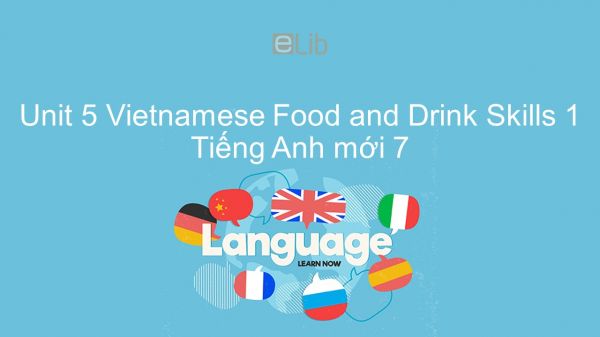
1. Reading
1.1. Task 1 Unit 5 lớp 7
Read Phong's blog. Find the words from the box below in the text and underline them. Use the words around each underlined word to help you understand the meaning. (Đọc blog của Phong. Tìm những từ trong khung bên dưới trong bài khóa và gạch dưới chúng. Sử dụng những từ gần những từ gạch dưới để giúp em hiểu ý nghĩa.)

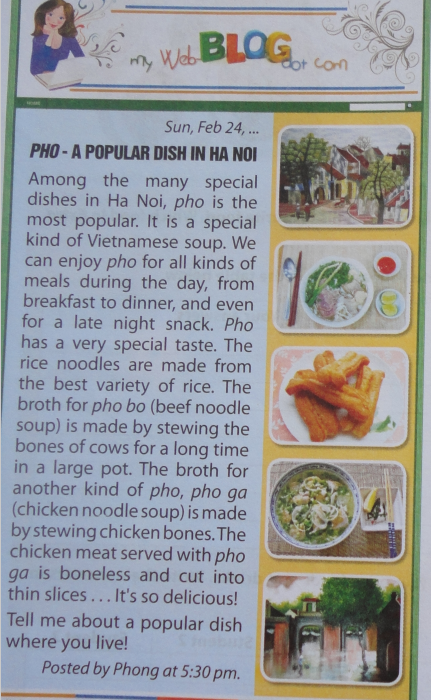
Guide to answer
PHO - A POPULAR DISH IN HA NOI
Among the many special dishes in Ha Noi, pho is the most popular. It is a special kind of Vietnamese soup. We can enjoy pho for all kinds of meals during the day, from breakfast to dinner, and even for a late night snack. Pho has a very special taste. The rice noodles are made from the best variety of rice. The broth for pho bo (beef noodle soup) is made by stewing the bones of cows for a long time in a large pot. The broth for another kind of pho, pho ga (chicken noodle soup) is made by stewing chicken bones. The chicken meat served with pho ga is boneless and cut into thin slices... It's so delicious!
Tell me about a popular dish where you live!
Posted by Phong at 5:30 p.m.
Tạm dịch:
PHỞ - MỘT MÓN ĂN PHỔ BIẾN Ở HÀ NỘI
Trong số nhiều món ăn đặc biệt ở Hà Nội, phở là món ăn phổ biến nhất. Nó là một loại canh (súp) đặc biệt của Việt Nam. Chúng ta có thể ăn phở thay thế cho bữa ăn trong ngày, từ bữa sáng đến bữa tối, và thậm chí là bữa ăn muộn ban đêm (ăn khuya). Phở có mùi vị rất đặc biệt. Sợi phở làm bằng gạo, được làm từ những loại gạo tốt nhất. Nước hầm thịt cho phở bò được thực hiện bằng cách hầm xương bò trong một nồi lớn với một thời gian dài. Nước thịt cho một loại phở khác, phở gà được thực hiện từ xương gà hầm. Thịt gà ăn kèm với phở gà là thịt gà không xương, và được cắt thành những miếng mỏng... nó rất ngon! Hãy nói cho chúng tôi nghe về món ăn yêu thích ở nơi bạn sống nhé!
1.2. Task 2 Unit 5 lớp 7
Read Phong's blog again and answer questions. (Đọc lại blog của Phong lần nữa và trả lời câu hỏi sau.)
1. When can we enjoy pho? (Khi nào chúng ta ăn phở?)
2. What are the noodles made from? (Sợi phở được làm bằng gì?)
3. How is the broth for pho bo (beef noodle soup) and pho ga (chicken noodle soup) made?
(Nước thịt cho phở bò và phở gà được làm từ gì?)
4. How is the chicken meat served with pho ga? (Thịt gà được ăn với phở gà như thế nào?)
Guide to answer
1. We can enjoy pho for all kinds of meals during a day, from breakfast to dinner, and even for a late night snack. (Chúng ta có thể ăn phở cho tất cả các bữa ăn, từ bữa sáng đến bữa tối, thậm chí cho bữa ăn khuya.)
2. They are made from the best variety of rice. (Chúng được làm từ nhiều loại gạo hảo hạng.)
3. The broth for pho bo is made by stewing the bones of cows for a long time in a large pot. The broth for pho ga is made by stewing chicken bones. (Nước phở bò được hầm từ xương bò với một thời gian dài trong nồi lớn. Nước phở gà được hầm bằng xương gà.)
4. It is boneless and cut into thin slices. (Nó được rút xương và cắt thành lát mỏng.)
2. Speaking
2.1. Task 3 Unit 5 lớp 7
Look at the list of ingredients below. Work pairs. Ask and answer questions about the ingredients for an omelette (Nhìn vào danh sách thành phần bên dưới. Làm theo cặp. Hỏi và trả lời những câu hỏi về các thành phần để làm một trứng ốp la.)
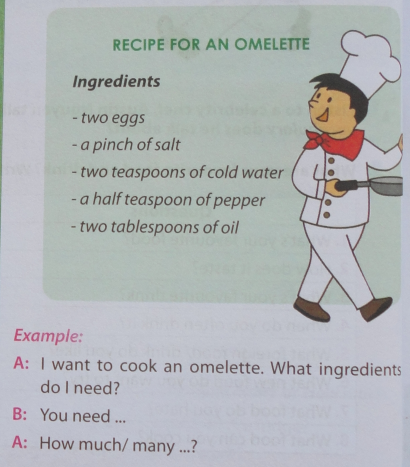
Tạm dịch:
CÔNG THỨC MÓN TRỨNG ỐP LA
Thành phần
- hai quả trứng
- một nhúm muối
- hai muỗng cà phê nước lọc
- nửa muỗng cà phê tiêu
- hai muỗng canh dầu ăn
Ví dụ:
A: Tôi muốn làm món trứng ốp la. Tôi cần những nguyên liệu gì?
B: Bạn cần......
A: Bao nhiêu.....?
Guide to answer
A: I want to cook an omelette. What ingredients do I need?
B: You need: egg, salt, cold water, pepper, oil.
A: How many eggs do I need?
B: 2 eggs.
A: How much salt, cold water, pepper and oil do I need?
B: You need a pinch of salt, two teaspoons of cold water, a half teaspoon of pepper, and two tablespoons of oil.
Tạm dịch:
A: Tôi muốn làm món trứng ốp la. Tôi cần những nguyên liệu gì?
B: Bạn cần trứng, muối, nước lọc, tiêu, dầu ăn.
A: Tôi cần bao nhiêu trứng?
B: Hai quả.
A: Tôi cần bao nhiêu muối, nước lọc, tiêu và dầu ăn?
B: Bạn cần một ít muối, hai muỗng cà phê nước lọc, nửa muỗng tiêu và hai muỗng canh dầu ăn.
2.2. Task 4 Unit 5 lớp 7
Look at the pictures of how to cook an omelette. (Nhìn vào những bức hình về cách chiên trứng ốp la.)
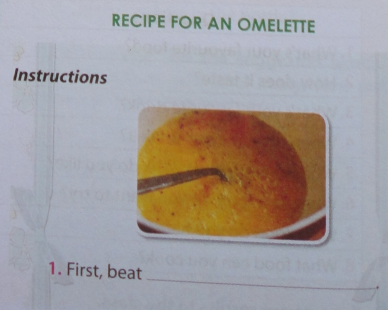
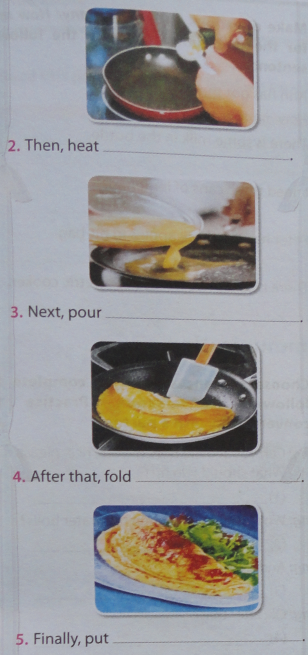
Use the phrases in this box to complete the above instructions (Dùng những cụm từ có trong khung để hoàn thành hướng dẫn sau.)
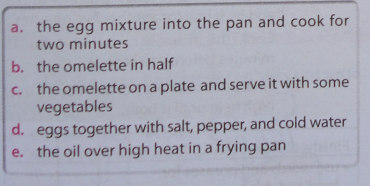
Guide to answer
1-d. First, beat the eggs together with salt pepper and cold water.
(Đầu tiên, đánh trứng với muối, tiêu và nước lọc.)
2-e. Then, heat the oil over high heat in a frying pan.
(Sau đó, đun nóng dầu với nhiệt độ cao trong chảo chiên.)
3-a. Next, pour the egg mixture into the pan and cook for two minutes.
(Kế đến, đổ hỗn hợp trứng vào chảo và nấu trong 2 phút.)
4-b. After that, fold the omelette in half.
(Sau đó, gấp trứng lại một nửa.)
5-c. Finally, put the omelette on a plate and serve it with some vegetables.
(Cuối cùng, bỏ trứng ốp la vào đĩa và ăn nó với rau.)
2.3. Task 5 Unit 5 lớp 7
Work in pairs. Practise giving instructions on how to make a dish or drink. (Làm theo cặp. Đưa ra hướng dẫn về cách làm một món ăn hoặc thức uống.)
Guide to answer
A: Can you tell me how to make a cup of tea, please? What should I do first?
B: Firstly, you need to boil fresh water. Boiling water will draw the best flavor out of the tea.
A: And then?
B: Put tea bags in mugs.
A: What next?
B: Next, you pour boiling water over the tea bags and let the tea brew for a few minutes.
A: And?
B: Finally, you should stir it with a spoon. Now it’s time for tea.
Tạm dịch:
A: Bạn có thể nói cho tôi biết cách nấu cơm không? Đầu tiên tôi nên làm gi?
B: Đầu tiên, bạn phải nấu nước sôi. Nước sôi làm cho trà có hương vị ngon nhất.
A: Sau đó?
B: Đặt túi trà vào ly.
A: Kế đến?
B: Tiếp theo, chế nước sôi lên túi trà và để trà ủ trong vài phút.
A: Và?
B: Cuối cùng, bạn nên khuấy trà với một cái muỗng. Đến lúc uống trà rồi.
3. Practice Task 1
True or False? (Chọn True (Đúng) hoặc False (Sai))
Green tea
Green tea must always be the first to be mentioned whenever one talks about Vietnamese tea. From the middle of the 20th century, green tea has been planted extensively throughout the North and the Middle of Vietnam, gradually becoming a symbol of Vietnamese' everyday life, of the peaceful countryside regions.
Green tea is very amiable to Vietnam' soil and climate, as it can be found widely in not only plain but also highland areas, sometimes right in the family backyard's gardens. With the higher trunk and larger in size of leaves in comparison with other tea plants, green tea can be enjoyed fresh and there is no need to wilt or oxidize; people can enjoy it right after picking the leaves from the tree. Steeping and boiling the tea leaves in hot water, after fifteen minutes, your green tea is ready to be served. Vietnam has been always an agricultural country, since people in rural area earn a living mainly from farming. It is the keeping-cool characteristic that makes green tea a perfect beverage for hot summer days in the tropical land. Besides blowing out the heat from the inside, green tea also helps improving the body's resistance to infection. Unsurprisingly, green tea has been considered an indispensable part of Vietnamese farmers' ordinary life.
Nowadays, acknowledging about Vietnamese ardor for green tea and its positive affects on health, some shrewd producers have convert this folk beverage into canned drink, bringing green tea closer to urban citizens as well as foreigners.
Question 1: From the middle of the 20th century, green tea has been planted extensively throughout the South of Vietnam.
Question 2: Vietnam's climate is favorable for growth of green tea.
Question 3: Green tea is good for people health.
Question 4: Nowadays, some producers have converted this folk beverage into canned drink.
Question 5: Green tea is very expensive so only the rich can buy it.
4. Practice Task 1
Choose the best one to complete the sentence. (Chọn đáp án đúng để hoàn thành câu)
Question 1: I’ll try to call you tonight, but I don’t have _______ time.
A. many B. some C. much D. few
Question 2: How _______ times do you brush your teeth every day?
A. much B. few C. some D. many
Question 3: Shall I make some more tea? I didn’t make _______.
A. much B. more C. some D. any
Question 4: Kate only ate a sandwich because she didn’t have _______ money.
A. many B. some C. few D. much
Question 5: There weren’t _______ seats some of us had to stand up.
A. much B. many C. some D. little
5. Conclusion
Kết thúc bài học, các em cần làm bài tập đầy đủ, luyện tập đọc hiểu và trả lời các câu hỏi liên quan, luyện tập nói về các bước làm nên một món ăn; đồng thời ghi nhớ các từ vựng có trong bài:
- stew /stjuː/ hầm
- bone /bəʊn/ xương
- boneless /ˈbəʊnləs/ không xương
- broth /brɒθ/ nước dùng
- slice /slaɪs/ lát mỏng
- recipe /ˈresəpi/ công thức (nấu ăn)
- boil /bɔɪl/ nấu, đun
Tham khảo thêm
- doc Unit 5 lớp 7: Vietnamese Food and Drink - Getting Started
- doc Unit 5 lớp 7: Vietnamese Food and Drink - A Closer Look 1
- doc Unit 5 lớp 7: Vietnamese Food and Drink - A Closer Look 2
- doc Unit 5 lớp 7: Vietnamese Food and Drink - Communication
- doc Unit 5 lớp 7: Vietnamese Food and Drink - Skills 2
- doc Unit 5 lớp 7: Vietnamese Food and Drink - Looking Back
- doc Unit 5 lớp 7: Vietnamese Food and Drink - Project
